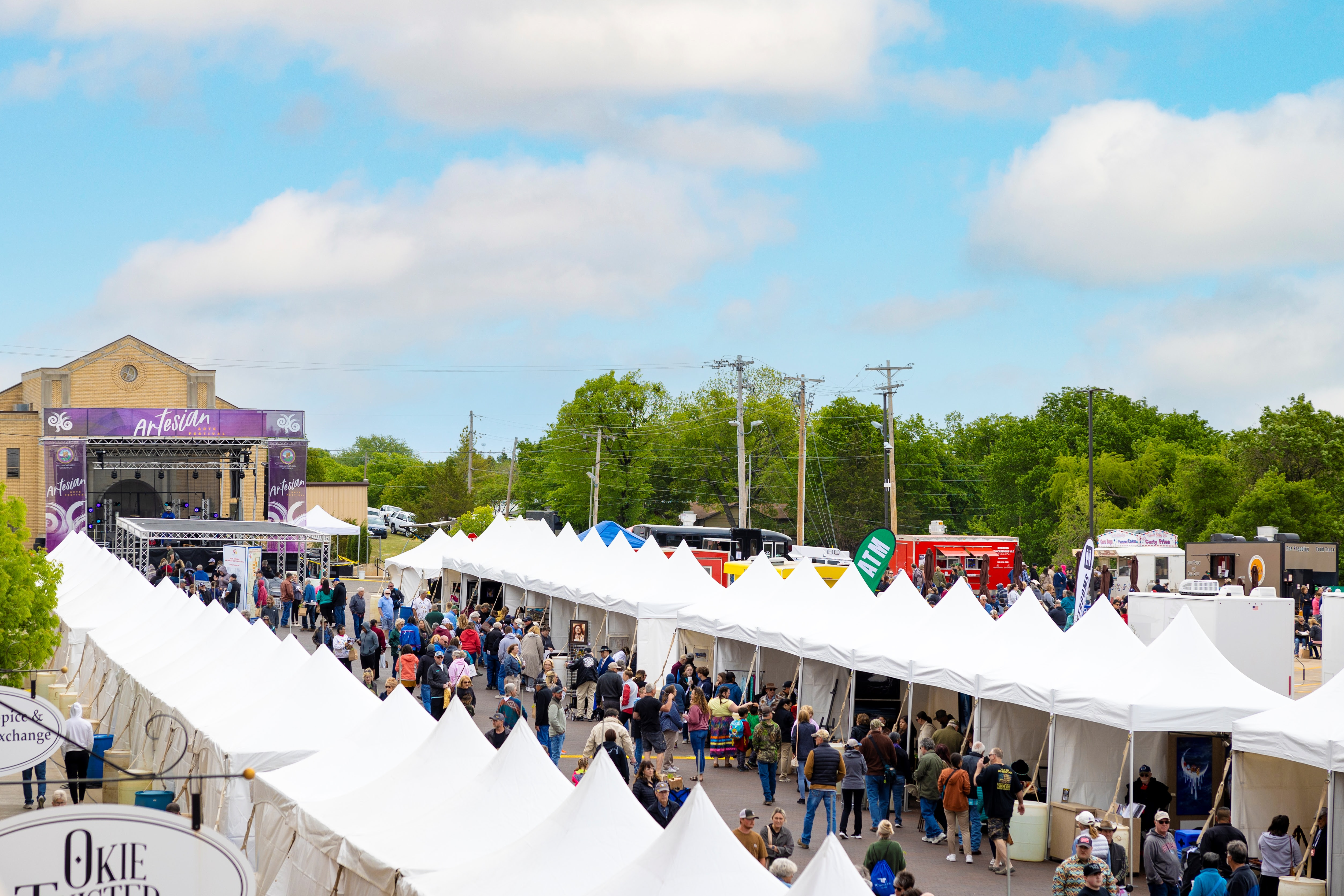
- Details
- By Chickasaw Nation Media
SULPHUR, Okla. – Downtown Sulphur was once again a flurry of activity June 7 as the vibrant sights and sounds of the annual Artesian Arts Festival attracted thousands of art patrons and families.
More than 125 First American artists from across the United States showcased an array of colorful original art — from abstract art to zoomorphic works — in tents along the brick streets of the Artesian Plaza.
Works by three Chickasaw artists and one Cherokee artist earned top awards at the 12th annual Artesian Arts Festival.
Chickasaw artist Regina Free’s work “Osi” (eagle) was named Best of Show by Artesian Arts Festival judges. “Osi” is a life-size sculpture made entirely of paper and foam except for the wood used for the talons and the bird’s eyes. Each feather was hand-painted.
Chickasaw artist Dustin Mater’s series titled “Aialhika” (justice) was awarded Best of 2-D by Artesian Arts Festival judges.
“Dancer,” a wooden sculpture created by Chickasaw artist Micah Hart, was named Best in 3-D by festival judges.
Best of Culture was awarded to Cherokee artist Talisha Lewallen for “The Indian Blanket,” an intricately woven basket.
Chickasaw artisan Amanda Schultz returned to the Artesian Arts Festival this year. Her booth displayed her Mandarella’s Workshop handmade clay earrings and was filled with happy shoppers selecting their favorite pair.
“This is my third year in a row to have done the Artesian Arts Festival and I really enjoy this festival,” Schultz, of Ada, Oklahoma, said, adding it ranks as her favorite event to showcase her art.
She enjoys visiting with repeat customers, some wearing the earrings they previously purchased from her. “They are always excited to come back to see my new creations and buy new earrings from me. Just watching my customers admire my clay artwork is worth all the hard work that goes into prepping for the shows.”
Schultz said the hospitality of the Chickasaw Nation employees and volunteers is always top notch and appreciated.
Santo Domingo (Kewa) Pueblo artists Emilio and Marguerite Chavez traveled from New Mexico to participate in their first Artesian Arts Festival and noted they had an enjoyable experience.
Their booth displayed beautiful turquoise, abalone and silver jewelry, and the couple shared the cultural significance of the stones with those who browsed their booth.
Throughout the day, dance demonstrations from the Chickasaw Nation Dance Troupe, Cellicion Traditional Zuni Dancers, Mitotiliztli Yaoyollohtli Aztec Dancers and Oklahoma Fancy Dancers captivated the crowd. Students from the Chickasaw Nation Dance Studio also performed several times during the festival.
The main stage was the scene for a vast array of live musical performances during the event.
The children’s activity booth was a popular spot for families to enjoy make-and-take crafts as well as an opportunity for the youth to have their faces painted with colorful designs.
Rescheduled from early April due to adverse weather conditions in the area, the 2025 Artesian Arts Festival was a community effort and marked the first arts festival conducted since a tornado devastated much of the downtown area more than one year ago.
For more information, visit ArtesianArtsFestival.com.
More Stories Like This
A Native American Heritage Month Playlist You Can Listen to All Year Long11 Native Actors You Should Know
Five Native American Films You Should Watch This Thanksgiving Weekend
Heavy metal is healing teens on the Blackfeet Nation
Over 150 Tribal Museums Participate in Fourth Annual Celebration of Native Life
Help us tell the stories that could save Native languages and food traditions
At a critical moment for Indian Country, Native News Online is embarking on our most ambitious reporting project yet: "Cultivating Culture," a three-year investigation into two forces shaping Native community survival—food sovereignty and language revitalization.
The devastating impact of COVID-19 accelerated the loss of Native elders and with them, irreplaceable cultural knowledge. Yet across tribal communities, innovative leaders are fighting back, reclaiming traditional food systems and breathing new life into Native languages. These aren't just cultural preservation efforts—they're powerful pathways to community health, healing, and resilience.
Our dedicated reporting team will spend three years documenting these stories through on-the-ground reporting in 18 tribal communities, producing over 200 in-depth stories, 18 podcast episodes, and multimedia content that amplifies Indigenous voices. We'll show policymakers, funders, and allies how cultural restoration directly impacts physical and mental wellness while celebrating successful models of sovereignty and self-determination.
This isn't corporate media parachuting into Indian Country for a quick story. This is sustained, relationship-based journalism by Native reporters who understand these communities. It's "Warrior Journalism"—fearless reporting that serves the 5.5 million readers who depend on us for news that mainstream media often ignores.
We need your help right now. While we've secured partial funding, we're still $450,000 short of our three-year budget. Our immediate goal is $25,000 this month to keep this critical work moving forward—funding reporter salaries, travel to remote communities, photography, and the deep reporting these stories deserve.
Every dollar directly supports Indigenous journalists telling Indigenous stories. Whether it's $5 or $50, your contribution ensures these vital narratives of resilience, innovation, and hope don't disappear into silence.
 The stakes couldn't be higher. Native languages are being lost at an alarming rate. Food insecurity plagues many tribal communities. But solutions are emerging, and these stories need to be told.
The stakes couldn't be higher. Native languages are being lost at an alarming rate. Food insecurity plagues many tribal communities. But solutions are emerging, and these stories need to be told.
Support independent Native journalism. Fund the stories that matter.
Levi Rickert (Potawatomi), Editor & Publisher
